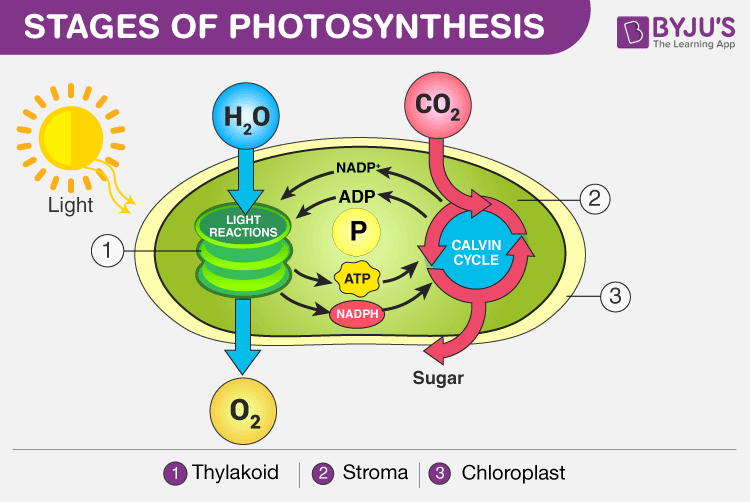What Happens to Co2 in the Calvin Cycle
MeaningProcessCarbon Fixation in C3 PlantsCarbon Fixation in C4 PlantsCarbon Fixation in CAM Plants
Carbon fixation means assimilation of inorganic carbon and conversion to organic compounds, which can be used as an energy store and for the synthesis of biomolecules.
Carbon Fixation Definition
"Carbon fixation is the process by which plants set up atmospheric carbon to course organic compounds."
All the autotrophs, bacteria, algae and plants set up atmospheric carbon dioxide by the process of photosynthesis or chemosynthesis.
Carbon Fixation Process
Photosynthesis is the primary process of carbon fixation. Carbon fixation occurs in the dark reaction or low-cal-contained reaction of the photosynthesis procedure.
The process of carbon fixation slightly differs in C3, Cfour, and CAM plants just the Calvin Bicycle or C3 pathway is the main biosynthetic pathway of carbon fixation.

Carbon Fixation in C3 Plants
Carbon fixation in C3 plants occurs in the dark reaction or low-cal-contained reaction of photosynthesis. It is also known equally the Calvin Wheel.
Calvin wheel occurs in all the plants, exist it C3, Cfour, CAM or whatever other plants.
- It occurs in the stroma of chloroplasts
- The showtime production of carbon dioxide fixation is iii carbon compound known equally 3-phosphoglyceric acid or PGA
- COii acceptor is a 5 carbon compound ribulose biphosphate or RUBP
- Calvin bike has three main steps:
- Carboxylation – In this process CO2 fixation takes place. Enzyme RUBP carboxylase oxygenase or RuBisCO catalyses the carboxylation of RUBP to course PGA.
- Reduction – Formation of carbohydrate or glucose takes place by reduction. ATP and NADPH formed during low-cal reaction are used in the procedure. 2 ATP and ii NADPH are used per cycle.
- Regeneration – Regeneration of RUBP is an important step for the cycle to go along, 1 ATP molecule is used for phosphorylation.
- Ane molecule of glucose requires half dozen cycle repetition, hence in total 6COii, 18ATP and 12NADPH are utilized in half-dozen Calvin cycles to form one glucose.

Carbon Fixation in C4 Plants
C4 pathway of carbon fixation is adapted by plants establish in a dry tropical region, e.g. maize, sorghum, etc.
C3 and Civ pathway differ in the first production of carbon fixation. In C3 plants, 3 carbon compound 3-phosphogyceric acid (PGA) is produced, whereas, in C4 plants, 4 carbon compound oxaloacetic acid (OAA) is produced.
In Civ plants also Ciii pathway is used in the formation of a glucose molecule
- Cfour plants have Kranz beefcake in leaves to tolerate high temperature. Big bundle sheath cells are present effectually vascular bundles of leaves
- Bundle sheath cells have thick walls, no intercellular spaces and have large chloroplasts
- Carbon fixation occurs in mesophyll cells
- COii acceptor is a 3 carbon compound phosphoenolpyruvate (PEP)
- The enzyme PEP carboxylase (PEPcase) catalyses the reaction. Mesophyll cell lack RuBisCO
- The first product of carbon dioxide fixation is four carbon compound OAA
- OAA is then converted to other 4C acids like malic acid and aspartic acid. They are transported to bundle sheath cells
- By decarboxylation in package sheath cells, COtwo is released, which enters Calvin bike
- The 3-carbon acid is transported back to mesophyll cells
- The bundle sheath cells have RuBisCO simply lack PEPcase
Carbon Fixation in CAM Plants
CAM pathway of carbon fixation or Crassulacean acid metabolism is present in plants nowadays in arid conditions, e.g. cactus.
In the CAM pathway, plants take CO2 during the night through the stomatal opening. It is converted to malic acid (four carbon compound) and stored in vacuoles. During the daytime, malic acid is transported to chloroplast and CO2 is released, which enters the Calvin cycle.
As well see: CAM Plants
To summarize the Ciii cycle or Calvin bike is the main pathway of carbon fixation in plants.
Explore key concepts and important points with regards to NEET, only at BYJU'S. Check the NEET Study Fabric for all the important concepts and related topics.
Oft Asked Questions
What is carbon fixation and why is it important?
Carbon fixation is the process by which inorganic carbon from the temper is alloyed into living organisms and converted into organic compounds. These compounds are used to store chemical energy. Information technology is an essential process for the sustainability of life. Through this process, the energy in the biosphere becomes bachelor to living organisms and helps them perform various metabolic processes. The energy thus produced gets transferred to the different trophic levels and to all the living organisms.
What happens in carbon fixation?
Carbon fixation is a biosynthetic pathway by which atmospheric carbon is converted into metabolically active organic compounds. Carbon fixation in plants during photosynthesis utilises ATP and NADPH to digest carbon dioxide and grade carbohydrates.
What is carbon fixation in the Calvin bike?
Calvin wheel is the dark reaction of photosynthesis. Information technology is the biosynthetic phase where CO2 is converted into saccharide. It utilises ATP and NADPH produced during the light reaction of photosynthesis. Carbon fixation is the showtime step in the Calvin wheel where carboxylation of RUBP results in the fixation of CO2 to stable organic intermediate.
What are the alternative pathways for carbon fixation?
Calvin cycle is the primary pathway of carbon fixation in plants, algae and cyanobacteria. The alternative pathways of carbon fixation are:
- Reductive citric acrid cycle – in bacteria
- three-hydroxypropionate cycle – in bacteria and archaea
- Reductive acetyl CoA pathway – in leaner and archaea
What are the 3 stages of Calvin cycle?
The iii stages of Calvin cycle are:
- Carboxylation – It is the first step where RuBisCO catalyses the carboxylation of RUBP to form two molecules of PGA.
- Reduction – ATP and NADPH are utilised to grade glucose. Phosphoglyceric acid (3PGA) is reduced to form glyceraldehyde 3-phosphate (G3P).
- Regeneration – The principal acceptor of CO2, i.due east. RUBP is regenerated. ATP is utilised in this step for phosphorylation.
Does carbon fixation require low-cal?
Carbon fixation is a dark reaction or light-independent reaction of photosynthesis. It does not crave light straight simply depends on the products of the light reaction of photosynthesis, i.e. ATP and NADPH.
What enzyme is responsible for carbon fixation?
Enzyme RuBisCO (Ribulose-1,v-bisphosphate carboxylase-oxygenase) is responsible for carbon fixation past the Calvin wheel. It catalyses the carboxylation of RUBP to course two molecules of 3PGA.
Related Manufactures:
Source: https://byjus.com/neet/carbon-fixation/
0 Response to "What Happens to Co2 in the Calvin Cycle"
Post a Comment